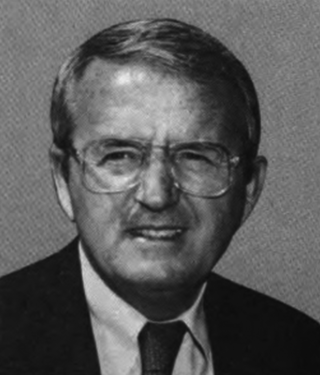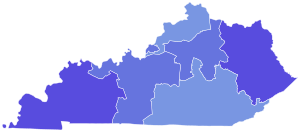
The governor of the Commonwealth of Kentucky is the head of government in Kentucky. Sixty-two men and one woman have served as governor of Kentucky. The governor's term is four years in length; since 1992, incumbents have been able to seek re-election once before becoming ineligible for four years. Throughout the state's history, four men have served two non-consecutive terms as governor, and four others have served two consecutive terms, the most recent being current governor Andy Beshear, who was re-elected to a second term on November 7, 2023. Kentucky is one of only five U.S. states that hold gubernatorial elections in odd-numbered years.

Brereton Chandler Jones was an American politician from the Commonwealth of Kentucky. From 1991 to 1995, he was the state's 58th governor, and had served from 1987 to 1991 as the 50th lieutenant governor of Kentucky. After his governorship, he chaired the Kentucky Equine Education Project (KEEP), a lobbying organization for the Kentucky horse industry.

Henry Scott Baesler is an American Democratic politician and former Representative from the Commonwealth of Kentucky.

Wallace Glenn Wilkinson was an American businessman and politician from the Commonwealth of Kentucky. From 1987 to 1991, he served as the state's 57th governor. Wilkinson dropped out of college at the University of Kentucky in 1962 to attend to a book retail business he started. The business rapidly became a national success, and Wilkinson re-invested his profits in real estate, farming, transportation, banking, coal, and construction ventures, becoming extremely wealthy. In 1987, he joined a crowded field in the Democratic gubernatorial primary. After running behind two former governors and the sitting lieutenant governor for most of the race, Wilkinson began to climb in the polls after hiring then-unknown campaign consultant James Carville. Wilkinson campaigned on a promise of no new taxes and advocated a state lottery as an alternative means of raising money for the state. Wilkinson surprised most political observers by winning the primary and going on to defeat his Republican challenger in the general election.

Larry Jones Hopkins was an American businessman and politician who represented Kentucky's 6th congressional district in the United States House of Representatives from 1979 to 1993. He was the Republican nominee for governor of Kentucky in 1991 and lost to Brereton C. Jones.
Harvey I. Sloane, a physician and Democrat, served two terms as Mayor of Louisville, Kentucky and also a term as county judge-executive of Jefferson County, Kentucky. He narrowly lost two Democratic primaries for Governor of Kentucky and lost a race for the United States Senate to incumbent Mitch McConnell.
Shirley Webster Palmer-Ball was a politically active Kentucky Republican who was his party's nominee for lieutenant governor in 1975.

Louis Gatewood Galbraith was an American author and attorney from the U.S. Commonwealth of Kentucky. He was a five-time political candidate for governor of Kentucky.

The Kentucky Democratic Party is the affiliate of the Democratic Party in the U.S. state of Kentucky. It is currently the minority party in the state, as the rival Republican Party of Kentucky overwhelmingly dominates in the state legislature, congressional delegation, and presidential elections. However, the party does currently control the governorship and lieutenant governorship, and maintains some strength in local elections.

United States gubernatorial elections were held on November 5, 1991, in three states and one territory. Prior to the elections, Democrats held two seats and Republicans held one. The national balance of power did not change as a result of the elections, but the balance of power shifted in two states.

Lawrence Eugene Forgy was an American Republican politician and gubernatorial candidate from Lexington, Kentucky.

The 1995 Kentucky gubernatorial election took place on November 7, 1995. Incumbent Governor Brereton Jones was not eligible to run for a second term due to term limits established by the Kentucky Constitution, creating an open seat. At the time, Kentucky and Virginia were the only states that prohibited their Governors from serving immediate successive terms. The Democratic nominee, Lieutenant Governor Paul E. Patton, defeated Republican nominee Larry Forgy to win his first term as governor. It was the last time that the election was held until the Kentucky General Assembly changed its term limits law in 1992, allowing Patton to run again in 1999 and leaving Virginia as the only state that prohibits its governor from serving immediate successive terms.

The 2015 Kentucky gubernatorial election took place on November 3, 2015. Incumbent Democratic governor Steve Beshear was ineligible to run for a third term due to term limits. Primary elections were held on May 19, 2015.

Mike Harmon is an American politician who served as the Kentucky auditor of public accounts from 2016 to 2024. He was previously a Republican member of the Kentucky House of Representatives for the 54th district. He was a 2011 candidate for Lieutenant Governor of Kentucky, but lost in the primary.

The 2019 Kentucky gubernatorial election took place on November 5, 2019, to elect the governor and lieutenant governor of Kentucky. The Democratic nominee, Andy Beshear, defeated Republican Incumbent governor Matt Bevin. It was the closest gubernatorial election by votes since 1899. It was the closest race of the 2019 gubernatorial election cycle.

A general election was held in the U.S. state of Kentucky on November 5, 2019, with all executive offices in the state up for election. Primary elections were held on May 21, 2019.

The 1987 Kentucky gubernatorial election was held on November 3, 1987. Democratic nominee Wallace Wilkinson defeated Republican nominee John Harper with 64.50% of the vote.

The 2023 Kentucky gubernatorial election was held on November 7, 2023, to elect the governor and lieutenant governor of Kentucky. Incumbent Democratic governor Andy Beshear won re-election to a second term, defeating Republican state Attorney General Daniel Cameron. If Cameron had won, he would have become Kentucky's first African-American governor.
Mary Louise Foust served three terms as the Kentucky Auditor of Public Accounts and was the first woman to run for Governor of Kentucky. She was also the first woman in the state to be a licensed attorney and a certified public accountant.

















